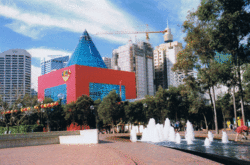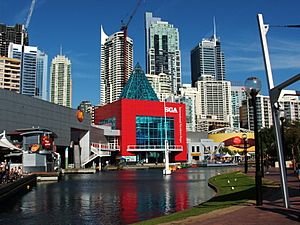Sega World Sydney facts for kids

The Sega World Sydney building
|
|
| Location | Darling Harbour, Sydney, Australia |
|---|---|
| Coordinates | 33°52′29″S 151°12′09″E / 33.8746°S 151.2025°E |
| Status | Removed |
| Opened | 6 March 1997 |
| Closed | 12 November 2000 (demolished 2008) |
| Slogan | Totally Out There |
| Attractions | |
| Total | 7 |
| Roller coasters | 1 |
Sega World Sydney was an exciting indoor amusement park in Sydney, Australia. It was filled with high-tech rides and games. The park was open for almost four years, from 1997 to 2000.
Sega World Sydney was part of a bigger area called the Darling Walk complex in Darling Harbour. The famous video game company Sega created and designed the park. It was one of several "SegaWorld" parks around the world.
The land for the park was bought in 1994, and Sega World opened in 1997. Other shops and fun places also rented space in the Darling Walk complex. By 2000, Sega was no longer involved in running the park. Sega World Sydney was not getting enough visitors and was losing money. People hoped that tourists coming for the 2000 Summer Olympics would help, but it didn't happen. So, Sega World closed in November 2000. Its rides were sold off in 2001.
The company that owned the land, Jacfun, tried to find a new business for the space. But the area was only allowed for entertainment use. This meant they couldn't build more profitable things like offices. In 2003, Jacfun sold their lease back to the Sydney Harbour Foreshore Authority. The old Sega World building was later taken down in 2008. A new building for the Commonwealth Bank was built there.
Contents
What Was Sega World Sydney?
Sega World Sydney cost about A$80 million to build. It opened in March 1997. The park used the newest technology for games and attractions. Some people even called it "Australia's Interactive Disneyland." Many of the park's themes were based on popular Sega games, especially Sonic the Hedgehog.
The park also hosted special dance parties for kids called Crush. These parties usually happened during school holidays.
Why Did Sega World Close?
Sega World Sydney closed in November 2000 because not enough people visited. It was always losing money. The park needed 800,000 visitors to break even, but it never reached that number. Even the many tourists for the 2000 Summer Olympics didn't help enough. Sega had sold its share in the park to Jacfun in 1999.
In March 2001, everything inside the park was sold at an auction. Only about 300 people came to buy things. Most of the rides were sold for very low prices. The two biggest rides, Rail Chase and Ghost Hunters, were bought by companies from other countries.
Awesome Rides and Games
Sega World Sydney had many cool rides and attractions:
- Rail Chase – This was an indoor roller coaster that looked like a mine train. It had amazing scenery and themes. After Sega World closed, this ride was sold to another park called Haailand and is still working there.
- Mad Bazooka – This ride was like a tank simulator. It had special bumper cars with cannons that shot balls. You would drive over balls on the floor to collect them, then shoot them at targets on other cars. This ride was removed in 1999 to make space for an ice rink.
- Ghost Hunters – This was an interactive ghost train. Riders used laser cannons to shoot at targets as they went through the ride. It was also sold to Haailand.
- Magic Motion 4D – A 4-D cinema that made you feel like you were part of the movie.
- Nickelodeon TV Machine – A fun play area for kids. It was themed like the TV channel Nickelodeon. It had activities like a climbing jungle, ball pits, and a spiral slide. The character Rocko was a big part of this area.
- Aqua Nova – A 3-D motion simulator. It felt like you were on a submarine exploring under the sea.
- AS-1 – Another motion simulator ride. It showed a futuristic chase scene. The famous singer Michael Jackson played the spacecraft captain in this ride.
Besides the rides, the park also had a fast-food restaurant. There was also a huge video arcade with over 100 arcade games. Before the park closed in 2000, all the games in the arcade were set to "Free Play," meaning you didn't need coins to play them!
Sonic Live in Sydney Show
Sega World Sydney hosted a live show called Sonic Live in Sydney. It lasted about 1½ hours. The story was based on the Sonic the Hedgehog cartoon series. In the show, Doctor Robotnik's Death Egg crashes in Australia. He tries to take over Sydney. But Sonic, Tails, and Princess Sally Acorn stop him. The audience could even interact a lot with the show!
The music and sounds for the show came from the Sonic The Hedgehog 2 video game. There were three songs: "What Are We Waiting For" sung by Sonic, "Give Me Chaos" sung by Dr. Robotnik, and "Thank You For Being You" sung by Sally. You could even buy a CD of the show's music at the park.
In 1998, the Sydney show stopped because Sega wasn't interested in it anymore. It was replaced by a puppet show version. This puppet show ran from 1998 until the park closed in 2000.
These two shows are special because they were some of the few times Sonic had a female voice actor. It was also the first time Tails had a female English voice actor. This later became common in games like Shadow the Hedgehog.
What Happened After Sega World?
Soon after Sega World closed, other big businesses in the Darling Walk complex also shut down. These included the Daintree Cafe and the One World Sports restaurant. The company Jacfun wanted to put another entertainment place there. But the rules for the area only allowed entertainment businesses.
In 2003, Jacfun sold the lease for the Darling Walk site back to the Sydney Harbour Foreshore Authority. They couldn't find a new main tenant and were losing money. By 2006, the only business left was a McDonald's restaurant. The old Sega World space was even used as a furniture warehouse for a while. From 2006 to 2007, the former One World Sports area was used for an MTV reality TV show called The Real World: Sydney.
In 2008, the Sydney Harbour Foreshore Authority leased the Darling Walk site to another company, Lend Lease. They planned to tear down the old building and build two new office buildings for the Commonwealth Bank. The old building was demolished in late 2008.
In 2018, a smaller statue of Sonic and Sally, like the big one that used to be outside the park, was found in a junkyard in Londonderry. The junkyard also had signs from another old Sydney theme park, Wonderland Sydney.



